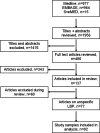Vertebral endplate signal changes (Modic change): a systematic literature review of prevalence and association with non-specific low back pain
- PMID: 18787845
- PMCID: PMC2583186
- DOI: 10.1007/s00586-008-0770-2
Vertebral endplate signal changes (Modic change): a systematic literature review of prevalence and association with non-specific low back pain
Abstract
The prevalence of "vertebral endplate signal changes" (VESC) and its association with low back pain (LBP) varies greatly between studies. This wide range in reported prevalence rates and associations with LBP could be explained by differences in the definitions of VESC, LBP, or study sample. The objectives of this systematic critical review were to investigate the current literature in relation to the prevalence of VESC (including Modic changes) and the association with non-specific low back pain (LBP). The MEDLINE, EMBASE, and SveMED databases were searched for the period 1984 to November 2007. Included were the articles that reported the prevalence of VESC in non-LBP, general, working, and clinical populations. Included were also articles that investigated the association between VESC and LBP. Articles on specific LBP conditions were excluded. A checklist including items related to the research questions and overall quality of the articles was used for data collection and quality assessment. The reported prevalence rates were studied in relation to mean age, gender, study sample, year of publication, country of study, and quality score. To estimate the association between VESC and LBP, 2 x 2 tables were created to calculate the exact odds ratio (OR) with 95% confidence intervals. Eighty-two study samples from 77 original articles were identified and included in the analysis. The median of the reported prevalence rates for any type of VESC was 43% in patients with non-specific LBP and/or sciatica and 6% in non-clinical populations. The prevalence was positively associated with age and was negatively associated with the overall quality of the studies. A positive association between VESC and non-specific LBP was found in seven of ten studies from the general, working, and clinical populations with ORs from 2.0 to 19.9. This systematic review shows that VESC is a common MRI-finding in patients with non-specific LBP and is associated with pain. However, it should be noted that VESC may be present in individuals without LBP.
Figures








References
Publication types
MeSH terms
LinkOut - more resources
Full Text Sources
Other Literature Sources
Medical
Miscellaneous

